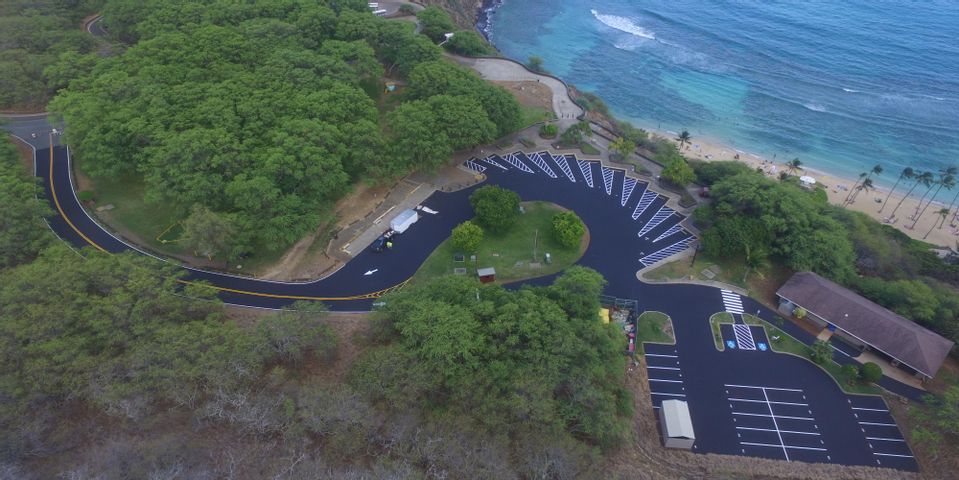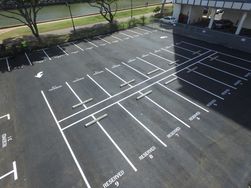
Parking lots need more than painted lines to function. The right design should maximize space, have simple pavement markings to keep traffic flowing, and provide a curb that instructs motorists where it’s safe to park. Before putting paint to the pavement, choose a design that will work best with your lot.
Designing an Efficient & Safe Parking Lot
1. General Planning
Large, heavy vehicles will wear down the asphalt quicker than smaller vehicles. This leads to cracks and potholes throughout the high-traffic areas in your lot. Keep a steady maintenance schedule and have the damage repaired as you find it.
Have the long sides of the parking lot run parallel and use straight striping to mark rectangular stalls. Add more spaces at the perimeter of the lot. This pattern is space-conscious and will allow for more stalls.
Other lots have pavement markings at 45, 60, or 90-degree angles. 45-degree and 60-degree stalls are best used for smaller lots. They provide enough traffic lane space to keep circulation from slowing. 90-degree stalls are recommended for larger lots that can accommodate the most vehicles.
Depending on your lot’s size, you’ll have room for one- or two-way aisle widths. These aisles allow pedestrians and drivers to circulate the lot safely. One-way aisles should be 12 feet wide, and two-way aisles should be 24 feet wide. Use arrow pavement markings to direct the flow of traffic and decrease congestion.
Hawaiian laws require a minimum of one handicap-accessible parking space for every 25. In larger lots, one out of every six handicapped spaces must be large enough to accommodate a van (eight feet by 11 feet).
2. Painting & Striping
 Your pavement markings need to be both visible and durable. Colors are used universally to alert drivers to an area’s purpose. Stalls are usually painted in white or yellow. Blue pavement markings are used for handicapped stalls.
Your pavement markings need to be both visible and durable. Colors are used universally to alert drivers to an area’s purpose. Stalls are usually painted in white or yellow. Blue pavement markings are used for handicapped stalls.
Curbs are often painted as well. Choose yellow for areas used only to load or unload passengers. Use red for areas where no parking or vehicle is standing allowed.
Select a paint brand that will last. Hawaiian heat and tire treads can wear paint down over time. Inspect and repaint areas as needed. Repainting increases your lot’s safety and curb appeal.
3. Asphalt Curbing
Without proper drainage, parking lots can collect water during storms. This can damage the asphalt and possibly flood cars. Asphalt curbing directs water flow from the lot and toward a drainage point, keeping the area and vehicles safe.
If you’re designing a new parking lot, reach out to Pacific Striping LLC in Honolulu, HI. They provide experienced parking lot maintenance, asphalt striping, and curb painting throughout Oahu. Known for their dedication, they offer 24/7 client support. For a full list of their services, including parking lot painting and pavement markings, visit their website. Call (808) 859-3664 to make an appointment.
About the Business
Have a question? Ask the experts!
Send your question

